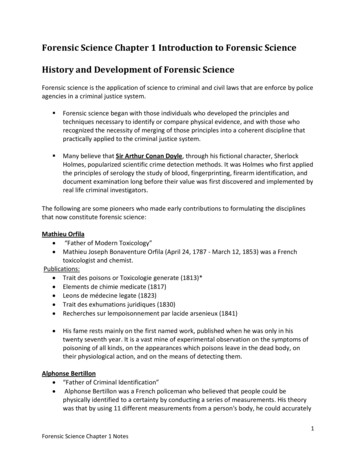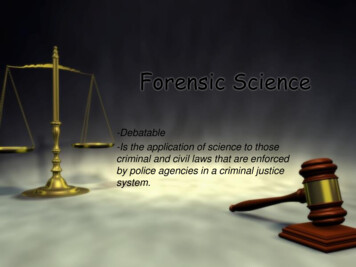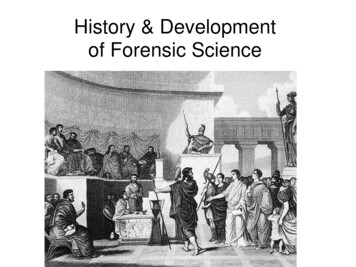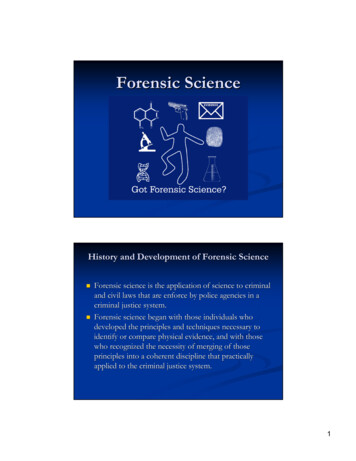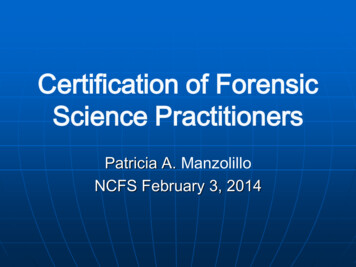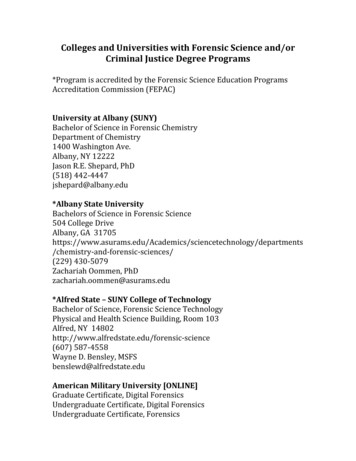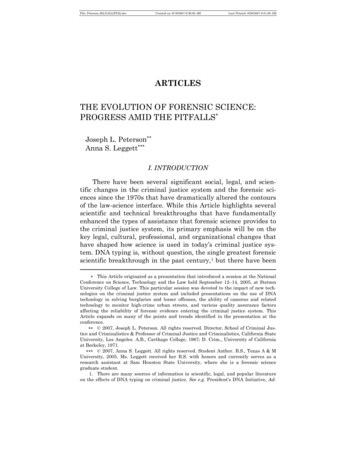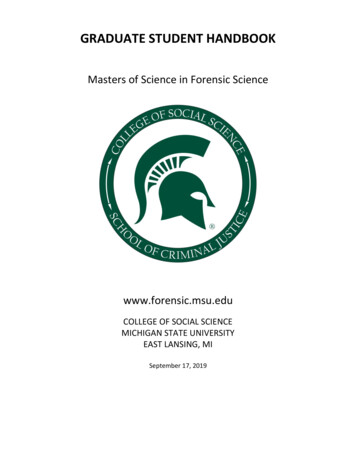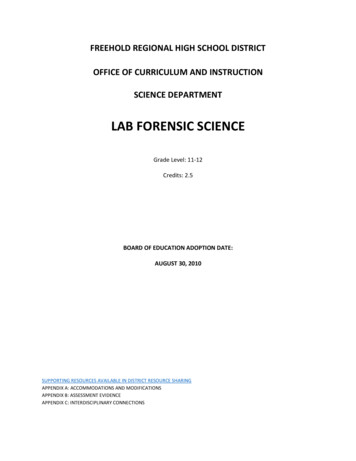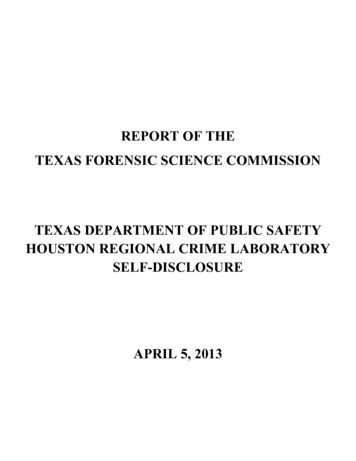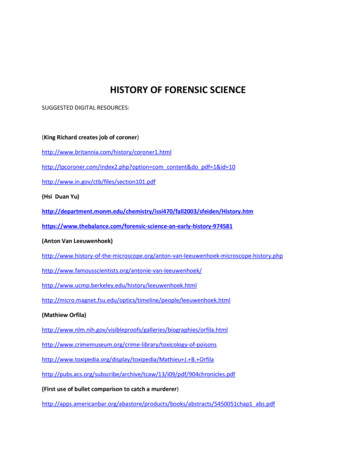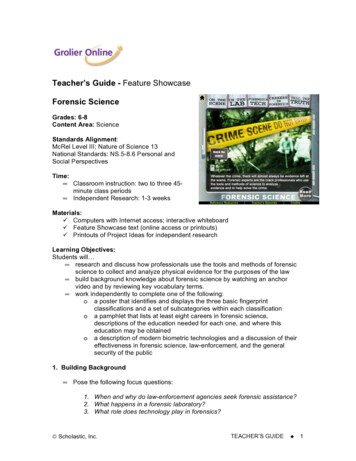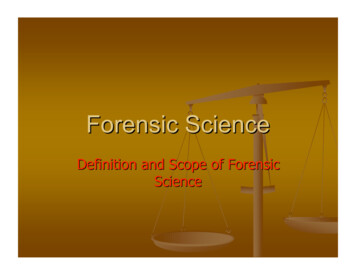
Transcription
Forensic ScienceDefinition and Scope of ForensicScience
Forensic Science is defined as theapplication of science to law. Forensics applies knowledge andtechnology of science for the definitionand enforcement of laws.Therefore Forensic science is the application ofscience to those criminal and civil lawsthat are enforced by police agencies in acriminal justice system.
What are the sciences involved inForensic Science? ChemistryBiologyPhysicsGeologyPhysiology Just to name a few!
History and Development ofForensic Science. Many persons believe that Sir ArthurConan Doyle had a huge influence in thecreation of Forensics with his fictionalcharacter Sherlock Homes.It was homes who first applied the newlydeveloping principles of serology,fingerprinting, forearm identification andquestioned documents long before realcriminal investigators.
Who is responsible for the creationof modern Forensic Science? The following is just a brief list of thosewho have made the earliest contributionsto the disciplines that now make upForensic Science.
Mathieu Orfila (1787-1853) Considered the Father of ForensicToxicology.Teacher of Medicine in SpainIn 1814, Orfila published the first paper onthe detection of poisons and their effectson animals.This established Forensic Toxicology as alegitimate scientific endeavor.
Alphonse Bertillon (1853-1914) Provided the first system of personalidentification.Developed the science of Anthropometry.Considered accurate at the timeAnthropometry was eventually replaced byfingerprinting in the 1900’s, Bertillon’searly efforts have earned him thedistinction as the father of criminalidentification.
Francis Galton (1822-1911) Undertook the first definitive study offingerprints and developed a methodology ofclassifying them for filing.In 1892, he published the book, Finger Prints,which contained the first statistical proof ofsupporting the uniqueness of his method ofpersonal identification. His work went on todescribe the basic principles that form thepresent system of identification by fingerprints.
Leone Lattes (1887-1954) In 1901, Dr. Karl Landsteiner discovered theblood can be grouped into different categories.These blood groups are known as A, B, AB. AndO.Dr Lattes intrigued by Dr. Landsteiners discoveryand its realization that these groups could beused for identification, assisted in the creation ofa simple blood test.This test help identify blood groups from driedblood specimens, which was immediately appliedto Criminalistics.
Calvin Goddard (1891-1955) A U.S. Army OfficerRefined a technique that allowed thecomparrision of a suspects bullet to a knownbullet.The technique utilized the comparrisonmicroscope.Goddard’s contribution established thecomparrison microscope as a indispensable toolof modern firarm examiners.
Albert S. Osborn (1858-1946) Developed the fundamental principles ofdocument examination.Osborn’s procedures allowed documentsto be admitted into courts as evidence.In 1910, Osborn authored the firstsignifigant text, Questioned Documents.This book is still considered the primaryreference for document examiners.
Walter C. McCrone (1916-2002) McCrone became the worlds leadingMicroscopist.Dr. McCrone was an advocate for the useof Microscopes to Forensic Cases.As a teacher he taught thousands ofForensic Scientists.Has evaluated thousands of pieces ofForensic Evidence in his career.
Hans Gross (1847-1915) The first paper written that concertedscientific applications to forensics waswritten by Hans Gross.Public Prosecutor and Judge in Austria.Published several book, 1: CriminalInvestigation and 2: Criminal Anthropologyand Criminalistics.
Edmond Locard (1877-1966) Created the first Crime Laboratory inLyons, France 1910.Eventually he became the founder anddirector of the Institutes of Criminalisticsat the University of Lyons which turnedinto the leading international school forForensic Scientists.His other Contributions
Locard’s Exchange Principle Locard strongly believed that everycriminal can be connected to a crime bydust particles carried from the crimescene.The formal definition: The exchange ofmaterials between two objects that occurswhenever two objects come into contactwith one another.
Back in the United States In 1932, J. Edgar Hoover organized the nationallaboratory, that aimed to offer forensic servicesto all law enforcement agencies in the country.The FBI is now the largest Forensic laboratory inthe world.In 1981, the FBI created a Forensic Researchand Training Center, dedicated to thedevelopment of new technologies to assist inthe Forensic investigative process.
In California The oldest crime lab in the United Statesis that of the Los Angeles PoliceDepartment in 1923.Founded by August Vollmer.August Vollmer’s work eventually createdthe Collage of Criminalistics at Universityof California @ Berkley in 1948.
Thank you for your attention!I hope you took notes
For Next Time! Please refer to the plan of the week foryou homework assignment duetomorrow!
Albert S. Osborn (1858-1946) Developed the fundamental principles of document examination. Osborn’s procedures allowed documents to be admitted into courts as evidence. In 1910, Osborn authored the first signifigant text, Questioned Documents. This book is still considered the
